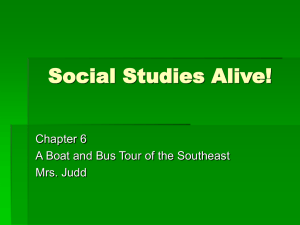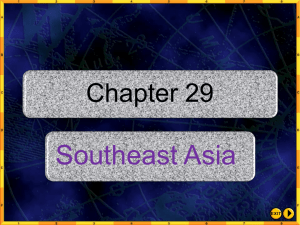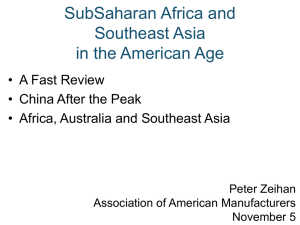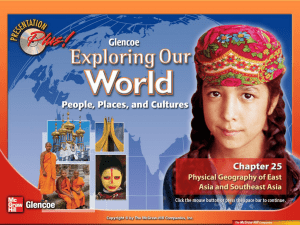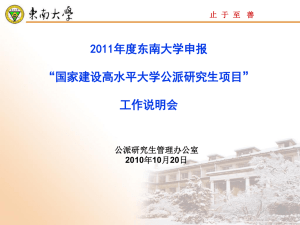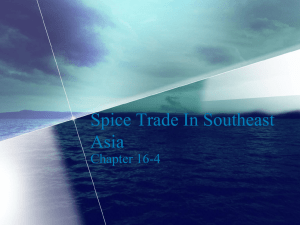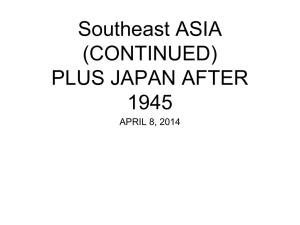Chapter 31 - Gainesville ISD
advertisement
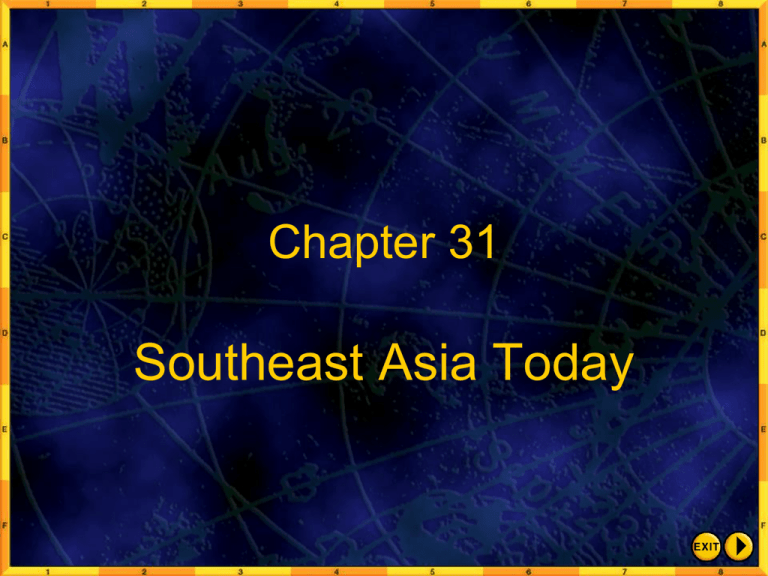
Chapter 31 Southeast Asia Today Chapter 30-1 Objectives • 1. Explain why rice farming is the most important agricultural activity in Southeast Asia. • 2. Examine why the countries of the region are industrializing at different rates. • 3. Discuss how the economies of Southeast Asia are becoming more interdependent. Terms to Know • • • • • • paddy sickle subsistence crop cash crop lode interdependent • ASEAN – • Association of Southeast Asian Nations • free port Drawing from Experience • If you were to name a food that you eat most often, what would it be? • Why do you eat this food so often? • In Southeast Asia, rice is a major food source because it grows well in the region. • This section focuses on the economic activities of Southeast Asia. Introduction • Some countries in Southeast Asia are setting up new industries. • The region’s economy, however, still mostly depends on agriculture. • What is the main economic activity in Southeast Asia? Agriculture (pg. 759) • Southeast Asia’s fertile river valleys and plains, soil, abundant water supply, and warm, wet climate make agriculture the main economic source. • Rice is the major food source in the region. • It is also a leading export among some countries. • Some kinds of rice plants need continual water supply from the time they are planted until just before harvest. • Seasonal flooding of rivers in parts of the region irrigates paddies, or flooded fields where rice is grown. • Some farmers grow a second crop by irrigating rice fields during the dry season. • Rice farming is hard work. • Rice is harvested manually by sickles. • Water buffalo/oxen are used to pull plows. sickle Oxen and Water Buffalo Vietnam Rice Paddies Cambodia Rice Paddy • Some grow other crops, such as yams and corn in areas too dry for a second planting of rice. • Some grow a root called cassava. • Cassava is much easier to grow. • Cassava is a subsistence crop because it is grown mainly to feed the farmer’s family. • Some raise pigs and poultry. Vietnamese Market Rubber Tree Plantation Tapping the sap (latex) The latex strip Thieves “Their stomachs is crying.” Cash Crops • are grown mainly to be sold… • Major cash crops include rubber, sugar cane, coconuts, coffee, palm oil and spices. Question • Why is rice an important crop grown in Southeast Asia? • answer: rice is a major food source and a leading export for Southeast Asia. Forests and Mines • Forestry is important to many countries in Southeast Asia. • Lumber, pulp and paper, and finished wood products are important to their economies. • Excessive logging has caused deforestation in several countries. • Rich mineral deposits are found in Southeast Asia’s mountains. • Important minerals found in the region include: • tin • iron ore • manganese & tungsten • crude oil • natural gas • Brunei has one of the world’s largest natural gas plants. • Indonesia is one of the top 10 producers of petroleum in OPEC (Organization of Petroleum Exporting Countries. • Irian Jaya has timber resources and rich lodes, or deposits, of minerals. Question • What natural resources are important to the economies of Southeast Asia? Industry • Industry is growing quickly in Southeast Asia. • Many workers in the region are leaving farms to work in urban industries. • Singapore, Malaysia, Thailand and the Philippines are Southeast Asia’s major industrializing countries. • Large debts, political corruption and financial problems created an economic crisis in 1997. • Singapore’s location makes it a major port, world trade center and manufacturing center. • It has established free trade zones that attract foreign businesses. • Malaysia has diversified its economic activities. • It manufactures many goods, such as steel, automobilies, and microchips. • Political problems and a rapidly growing population have slowed the economic growth in Indonesia. • Wars and political changes have slowed economic growth in Laos, Vietnam and Cambodia. • Myanmar is isolated from world markets, slowing its economic growth. • Its gross national product is among the lowest in the world. Question • What kinds of problems in the region have led to slow economic growth? Interdependence (p.763) • Recently, Southeast Asian countries have become more interdependent, or reliant on one another. • Two organizations have increased this interdependence. • The Asian Development Bank (ADB) provides international loans to aid the region’s economies. • The Association of Southeast Asian Nations (ASEAN) was formed to promote regional development, trade and greater economic stability. • Question: Why have Southeast Asian countries become interdependent? Transportation • Water transportation is the most common way to move people and goods in the region. • Southeast Asia is the crossroads of major ocean trade routes. • Most shipping between Europe and East Asia passes near Singapore, one of the world’s busiest ports. • Singapore is a free port, a place where goods can be unloaded, stored and reshipped without paying import duties. • There are many other ports in the region, including Jakarta, Manila and Ho Chi Minh City (Saigon). Overland Transportation • The quality of overland transportation in the region varies partly because of the differences in economic development. • The industrializing countries generally have better overland transportation. • People travel on bicycles, motor scooters and oxcarts. • In urban areas they also use trucks, automobiles and buses. • Travel is difficult in rural areas because of dense forests, unpaved roads and rugged land. • Question: Why is water transportation common in Southeast Asia? Ox Cart Cyclo’s By boat Motorcycles Communications (p.765) • Industrializing countries in the region have better communication services than countries that are less industrialized. • Singapore has a well-developed communications system. • Rural areas of the region tend to have little access to newspapers, tv and the internet. • Cities tend to have good communication. ? • What areas of Southeast Asia have good communication systems? Chapter 31-2 Objectives • Identify dangers posed by volcanoes, floods and typhoons in Southeast Asia. • Describe how economic progress has increased environmental pollution in the region. • Discuss the efforts underway to protect the environment in Southeast Asia. Terms to Know • cyclone • typhoon • shifting cultivation Drawing from Experience • What kinds of natural disasters commonly occur in the region where you live? • How do these affect you? • What kind of damage occurs with these natural disasters? • In the last section, you read about the economic activities of Southeast Asia. • This section focuses on the environmental problems. Introduction • Bangkok, the capital of Thailand, is noisy, crowded and polluted. • This capital city, like other places in Southeast Asia, faces many environmental challenges. Bangkok, Thailand Bangkok slums Flooding is a real threat! Nature’s Might • Much of Southeast Asia is part of the Ring of Fire, the area of earthquake and volcanic activity that surrounds the Pacific Ocean. • Coping with the effects of natural disasters is part of everyday life. • There are three kinds of common natural disasters in Southeast Asia. Ring of Fire Volcanoes • lots of activity in the last few years… • Most of the larger islands in the Philippines have volcanoes. • Many people have been killed. • Clouds of ash and dust blow into the atmosphere and affect weather patterns worldwide. • The people of Bali in Indonesia think of the volcano there as the sacred centerpiece of their Hindu beliefs. Batur Volcano on Bali Floods • Floods kill hundreds of people in the region every year. • Floods ruin millions of acres of crops. • In area’s where forests have been cleared, the floods cause water runoff and mudslides. • Rivers undergo seasonal flooding every year. Typhoons…Cyclones • Typhoons are tropical cyclones that form in the Pacific ocean. • Cyclones are storms with heavy rains and high winds that blow in a circular pattern around an area of low atmosphere. • Typhoons form south of the equator, usually between July and November. • Their winds blow in a counterclockwise direction. Typhoon Mike Question • What three natural disasters are common in Southeast Asia? • What are their effects? Environmental Pollution • Economic growth in Southeast Asia’s cities has raised living standards. • But it has also created environmental concerns. • As more people become wealthy, more buy automobiles. • This causes air pollution from car exhaust. • Growing populations in the cities creates shortages of housing, water supplies, sanitation and traffic control. • In Bangkok great population increases and industrialization have caused the city to overheat. • This causes health problems, air pollution and acid rain. • Singapore does not have as many pollution problems because they have strict laws against polluting. • In some rural areas of Southeast Asia, freshwater has been contaminated from poor waste disposal. • Volcanic eruptions and forest fires cause air pollution and health problems in rural areas. • Question: What are some causes of environmental pollution in Southeast Asia? Logging, Farming and Mining • A major concern throughout Southeast Asia is deforestation. • Timber is an important source of income in the region. • Commercial logging companies have helped build economic prosperity. • The widespread cutting of trees is using up the region’s forests. • Without the trees’ root system, heavy rains wash away the topsoil into streams. • This clogs the rivers and reduces the amount of water available for irrigation. • Excessive logging also causes major flooding and mudslides. Shifting Cultivation • Farming methods such as slash-and-burn agriculture and shifting cultivation add to deforestation and soil erosion. • In this farming method, forests are cleared to plant fields. • Farmers raise crops in the fields for a few years. • After the soil is used up, the farmers leave the fields and start the process over. • Plantation owners often burn areas of land for planting cash crops. • During droughts, these fires often burn out of control, destroying forested areas. Mining • Mining can also lead to environmental problems. • In Indonesia’s largest gold mine workers dump large amounts of rock waste into a river. • This will eventually cause the river to change course and flood the nearby forest. • Rock waste is already killing vegetation in the rain forest. ? • How do logging, farming and mining harm the environment of Southeast Asia? Environmental Protection (p.770) • Southeast Asian countries have taken steps to protect their environment. • Some countries are limiting timber exports and beginning reforestation programs. • Malaysia has been successful in managing its rain forests through conservation. • Countries such as Laos and Indonesia have planned migration or resettlement in order to balance economic development and environmental protection. • Indonesia has set aside land as a nature reserve, off limits to development. • Scientists have also proposed solutions to urban warming in Bangkok. • One proposal is to establish “Green Zones”. • Green Zones are special areas that are protected from development. • Another proposal would ban the construction of tall buildings near the sea, allowing the ocean wind to blow into the city. • Question: What solutions are being tried to solve environmental problems in the region? End of Slide Show
